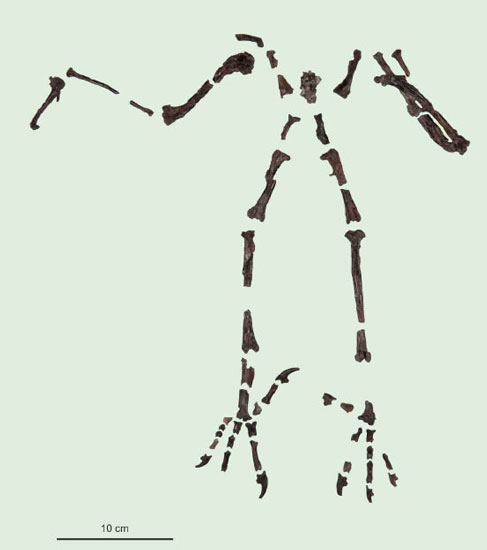Vicious Prehistoric Owl from the Bighorn Basin
Primoptynx poliotauros – Large Owl that Hunted like a Hawk!
With the extinction of the non-avian dinosaurs some 66 million years ago, our mammalian ancestors diversified and thrived. A large proportion of their predators had become extinct and this may have contributed to their success. However, our furry friends were not to have everything go their way, as within a few million years other vertebrates, notably the birds had themselves diversified and begun to fill predatory niches in terrestrial ecosystems once occupied by less derived maniraptorans.
Primoptynx poliotauros
For example, a new species of large owl has been described from postcranial remains found in the Bighorn Basin of Wyoming. This owl, which was approximately sixty centimetres tall, has particularly large and well developed talons on its hind and second toes. Writing in the “Journal of Vertebrate Palaeonotology”, the research team responsible for describing the fossil material conclude that this large bird was a very dangerous threat to the numerous species of small and medium sized mammals within the ecosystem. The owl has been named Primoptynx poliotauros.
The Fossil Remains of Primoptynx poliotauros Laid Out in Skeletal Position

Picture Credit: Senckenberg Research Institute/Tränkner
Big Owl with Big Talons
Lead author of the scientific paper, Dr Gerald Mayr, an ornithologist at the Senckenberg Research Institute and Natural History Museum Frankfurt commented:
“The fossil owl was about the size of a modern snowy owl (Bubo scandiacus). However, it is clearly distinguished from all extant species by the different size of its talons. While in present-day owls the talons on all toes are approximately the same size, Primoptynx poliotauros has noticeably enlarged talons on its hind toe and second toe.”
The scientists postulate that as this prehistoric owl has a longer first and second toe, as seen in extant hawks and other members of the Accipitridae family, such as such as the Harpy eagle (H. harpyja), this suggests that P. poliotauros used its feet to dispatch prey items in a hawk-like manner, in contrast to extant owls that kill prey with their beak.
Co-author of the paper, Dr Thierry Smith (Royal Belgian Institute of Natural Sciences), explained:
“Owls today have four toes with claws of equal size to catch relatively small preys and kill them with the beak. Primoptynx poliotauros has a longer first and second toe, as seen in hawks and other members of the family Accipitridae. Those more developed toes are used to pin down prey, which are punctured by the talons. So, it was an owl that hunted like a hawk on medium-sized mammals.”
From the Willwood Formation (Wyoming, USA)
The fossil material heralds from the Willwood Formation of the northern Bighorn Basin, Park County in Wyoming and the genus name is from the Latin for first “primus” and the “ptynx” for owl. Although around 55 million years old, Primoptynx was not the “first owl”, there is evidence to suggest that these birds originated in the Cretaceous.
The fossils help to confirm the widespread and diverse species of owls that were present during the Eocene Epoch. The success of owls (Strigiformes), runs in conjunction with the evolutionary development of placental mammals. The later extinction of Primoptynx poliotauros and prehistoric proto-owls may have been due to the emergence of diurnal birds of prey in the Late Eocene.
Everything Dinosaur acknowledges the assistance of a media release from the Royal Belgian Institute of Natural Sciences in the compilation of this article.
The scientific paper: “Skeleton of a new owl from the early Eocene of North America (Aves, Strigiformes) with an accipitrid-like foot morphology” by Gerald Mayr, Philip D. Gingerich and Thierry Smith published in the Journal of Vertebrate Paleontology.
The Everything Dinosaur website: Everything Dinosaur.

